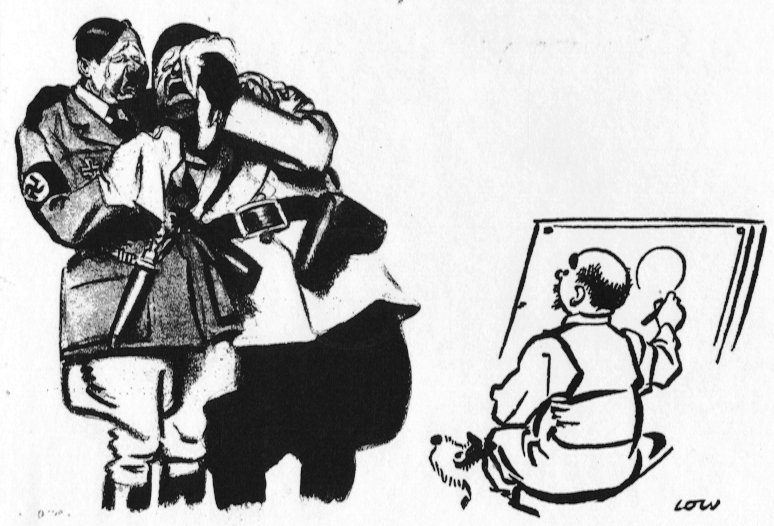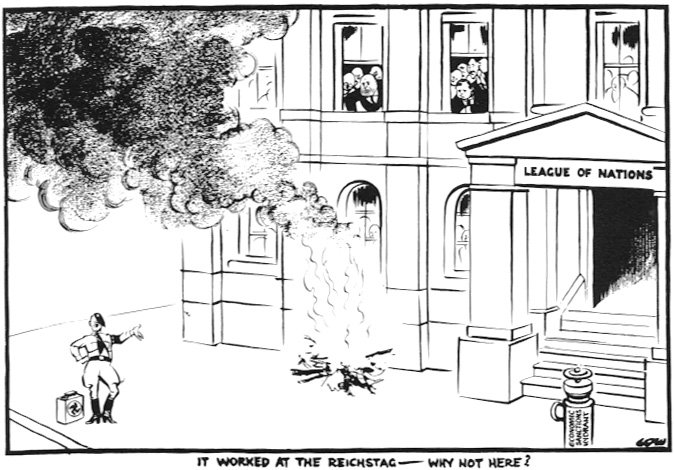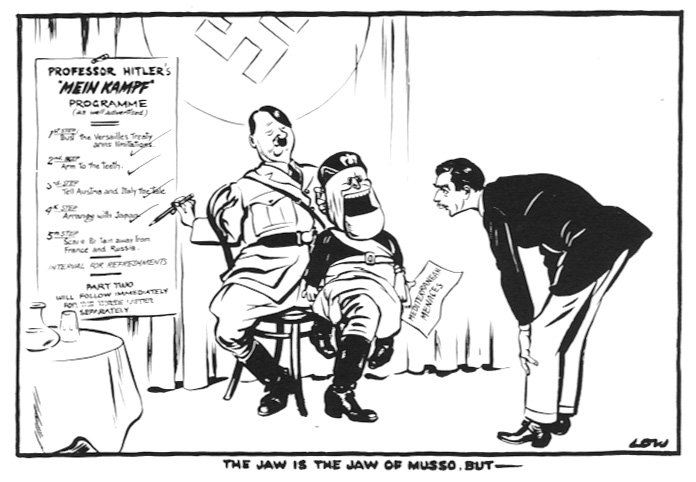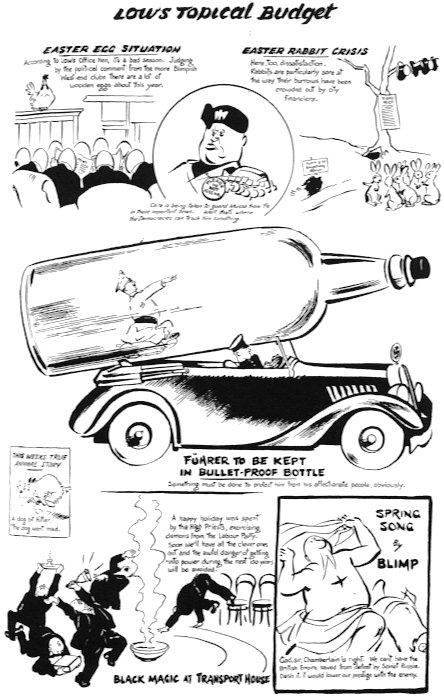David Low and the Dictators
by Dr Timothy S. Benson
Sir David Low (1891-1963) was probably the most celebrated political cartoonist of the last century. He is best remembered today for the way he mercilessly ridiculed in a humorous vein the dictators, Hitler and Mussolini during the 1930s. Despite several attempts to censor him, Low fought an almost personal war against Hitler and the Nazis which was played out for all to see in the pages of the Evening Standard. Michael Foot, who was Acting Editor on the Evening Standard from 1938, felt that Low's attacks on Hitler met with considerable success:
'Low contributed more than any other single figure and as a result changed the atmosphere in the way people saw Hitler. Other cartoonists did not have such a long-standing record.'
Low's humanitarian instincts and Liberal upbringing gave him a strong determination to oppose Hitler and everything he stood for. It would be Low's depiction of Hitler, above all others, that most got under the Fuhrer's skin. Consequently, the Nazis even tried, in 1937, to put pressure on the British Government to restrain Low from satirising Hitler in his cartoons. This only bolstered Low's reputation as an independent operator at the Evening Standard, especially when it was well-known that he worked for a proprietor such as Lord Beaverbrook, who was a consistent and staunch supporter of Chamberlain's Appeasement policy.
Low's cartoons against Hitlerism started as early as the Munich Putsch of November 1923. Low's intended target, however, was not Hitler himself, who was then comparatively obscure even in Germany, but the legendary First World War General, Erich Ludendorff, who was generally believed to have led the conspirators. It was not until the 27th September 1930 that Hitler first appeared in a Low cartoon entitled: LITTLE ADOLF TRIES ON THE SPIKED MOUSTACHE. Hitler's Nazi party had just made substantial gains in the German elections of 1930 which resulted in them becoming the second largest party in the Reichstag. Hitler boasted that if he became Chancellor he would not only withdraw Germany from the League of Nations but also make her militarily strong again. Low portrays Hitler in the guise of, and potential successor to, Kaiser Wilhelm II's militaristic legacy.
A few months later, Bruce Lockhart, as foreign correspondent of the Daily Express visited Germany to interview Hitler. During the interview, Hitler surprisingly mentioned Low in conversation and was full of praise for him in his mistaken belief that the cartoonist's attitude was anti-democratic because of the way he derided politicians and parties in his daily cartoons. According to Low: "At the time I was upbraiding democracy rather drastically for its attitude to European events and Hitler got the impression I was anti-democratic." Hitler then asked Lockhart if he could arrange for Low to let him have some originals to decorate the Brown House, the national headquarters of the Nazi party in Munich. When Lockhart relayed Hitler's request to Low upon his return, the cartoonist obligingly sent a couple as from in his words 'one artist to another'. Low admitted to seeing very much of the artist in Hitler:
"Hitler's political conceptions were the artist's perceptions, seen as shapes, laid on in wide sweeps, errors painted out and details left until later, the bold approach and no fumbling,"
Low did not see Hitler as others did, as some kind of mad man or evil genius. To the cartoonist, Hitler may not have been an intellect but his strength lay in his determination to achieve his aims and objectives whatever the cost, 'a simple mind uncomplicated by pity'. Unlike others, Low profited by always taking Hitler at his word. When he became Chancellor in 1933, Low noticed how Hitler made plain his ambitions for a greater Germany and domination of Europe. As a result, Low devoted the space he had on the Evening Standard to make light of Hitler's plans and soon became a prophet of remarkable insight as events unfolded in the way Low continually predicted they would throughout the 1930s.
When Hitler withdrew Germany from the League of Nations in November 1933, Low responded with a cartoon entitled IT  WORKED AT THE REICHSTAG - WHY NOT HERE? The cartoon was an allusion to the destruction of the Reichstagby fire earlier that year, when there had been evidence to show that the Nazis had used the incident as an excuse to eliminate their political opponents. Low's real target is not so much Hitler, as the weakness of League members to act against Hitler's unilateral action. However, the Nazi's took such an offence to it, that they permanently banned in Germany the Evening Standard and all papers printing Low's cartoons.
WORKED AT THE REICHSTAG - WHY NOT HERE? The cartoon was an allusion to the destruction of the Reichstagby fire earlier that year, when there had been evidence to show that the Nazis had used the incident as an excuse to eliminate their political opponents. Low's real target is not so much Hitler, as the weakness of League members to act against Hitler's unilateral action. However, the Nazi's took such an offence to it, that they permanently banned in Germany the Evening Standard and all papers printing Low's cartoons.
Low acknowledged that the banning of his cartoons in Germany did 'more good than harm' to his reputation within Britain and the rest of the world. Beaverbrook travelled to Germany in order to get the ban on his newspaper lifted, but the Nazis told him that the Evening Standard would remain banned as long as Low was it's cartoonist.
If Low had had the opportunity of choosing a Nazi Leader to caricature, it would certainly not have been Hitler, but, in his words, a 'big dark scowling man'. The cartoonist found that, as a subject for caricature, Hitler was clearly inferior compared to the other leading Nazis such as Hermann Goering and Josef Goebbels. Apart from the instantly recognisable forelock and Chaplinesque moustache, Hitler's overall features were weak. According to Low:
'Hitler is a mixed type unlike the Nordic type of Goering or the Mediterranean of Goebbels. One of my difficulties about Hitler is that I have to use fine lines to draw his eye, and when I send cartoons by radiogram to foreign countries the transmission process cannot pick up all these lines and my Hitler arrives at the other end with the lines lost on the way. Goebbels on the other hand, is good to draw - dark, sharp lines. As a citizen of the world I should not think it an improvement, but as a cartoonist I don't mind how soon Goebbels purges his friends and makes himself Public enemy No.1.'
Low personally found that he was far more effective in undermining Hitler by portraying him as a harmless fool or, as A.J.P. Taylor has said, 'a comic devil', than as a wicked or frightening monster, as he pointed out in 1940:
'No dictator is inconvenienced or even displeased by cartoons showing his terrible person stalking through blood and mud. That is the kind of idea about himself that a power-seeking world-beater would want to propagate. It not only feeds his vanity, but unfortunately it shows profitable returns in an awed world. What he does not want to get around is the idea that he is an ass, which is really damaging. I shall always remember Hitler, for instance, not as the majestic, monstrous myth of his propaganda build-up, but as the sissy who whined to the British Foreign Office about his dignity when I ran him for a while as a comic strip.'
However, by depicting Hitler as a figure of fun, Low may have inadvertently, to Beaverbrook's possible relief, made him appear less threatening to those that saw him in his cartoons, compared to, say, other cartoonists. By doing so, Low may have possibly dissipated the real threat that Hitler offered to the peace of Europe, thus proving counter-productive, as Beaverbrook may have appreciated. According to W.A. Coupe:
'Far from tearing the mask from public figures and holding up a warning finger to the reader, the tendency is to represent serious political problems in humorous allegorical guise and to invite us to laugh at our political predicaments, thereby in a way robbing them of their reality, or at least cocooning us from the horror in a web of gallows' humour. Low's hatred of fascism is beyond doubt, yet the cartoons of the thirties, in which he so often showed Hitler as a ludicrous, posturing and vain little fellow attended by a distinctly slow-witted, bruiser-like Mussolini, certainly did not strike alarm and despondency into his readers. Quite the contrary! In spite of his unimpeachable intentions, he probably contributed to the conviction that it "couldn't happen here". Such absurd little men surely could not constitute a serious political threat!'
The first documented incident where Low was asked to tone down his depiction of Hitler and the Nazis was during the Berlin Olympics in July 1936. This may have been directly due to Beaverbrook's visit to the Games, not wanting Low's cartoons to affect his personal relations with the Nazis whilst in Germany. The Assistant Editor of the Evening Standard, Stanley Tiquet, wrote to Low:
'During the period of the Olympic Games, especially, it is of vital importance that nothing should appear in English newspapers which might tend to prejudice international peace and, particularly, the good relations between all the countries now represented in Berlin. I rely on your kind co-operation in seeing that as far as the Evening Standard is concerned, nothing is published which is in the slightest degree likely to prove detrimental to our friendship with other nations.'
'During the period of the Olympic Games, especially, it is of vital importance that nothing should appear in English newspapers which might tend to prejudice international peace and, particularly, the good relations between all the countries now represented in Berlin. I rely on your kind co-operation in seeing that as far as the Evening Standard is concerned, nothing is published which is in the slightest degree likely to prove detrimental to our friendship with other nations.' Low did not appreciate any editor, let alone a stand-in one, cautioning him over his selection and treatment of subject-matter for his cartoons. In what appears as a sign of defiance, his response was to write indignantly at the bottom of Tiquet's letter: '!!? To hell with Tiquet.' Low ignored the warning and continued to deride the Nazi regime and Hitler's continual flagrant disregard of the Versailles Treaty. Four months after the 'To hell with Tiquet' episode, the Evening Standard felt that Low's concentration on Hitler had become too frequent and thus may have been appearing to the Evening Standard readership as a vendetta against the German Dictator. In November 1936, the editor, Percy Cudlipp, having no doubt confirmed with Beaverbrook, refused to publish 'THE JAW IS THE JAW OF MUSSO, BUT - '. In a letter to Low, Cudlipp wrote:
'We have talked over the ventriloquist cartoon very carefully, and have decided to hold it over for the present for this reason: We do not want at the present time to run what will seem to be a cartoonist's campaign against the dictators. You dealt with it on Monday, so that there can be no question of your appearing to ignore the international situation. But a succession of such cartoons at this time might very well do serious harm. The present international situation is one in which a newspaper must be very keenly alive to its responsibilities; and my admiration for the ventriloquist cartoon - and for the one you sent me on Friday - as works of art has now to be subjected to those responsibilities. I suggest, therefore, that for the present you avoid the dictators altogether.'
In the autumn of 1937, with tension in Europe mounting over the possibility of Hitler invading Austria, Cudlipp again felt that he had to warn Low to tone down his cartoons:
'You will see from the news that the state of Europe is extremely tense at the present time. That being so, I don't want to publish anything in the Evening Standard which would add to the tension, or inflame tempers any more than they are already inflamed. There are people whose tempers are inflamed more by a cartoon than by any letterpress. So will you please, when you are planning your cartoons, bear in mind my anxiety on this score?'
At around the same time, the then Foreign Secretary, Lord Halifax, accepted an invitation from Goering to attend the International Sporting Exhibition in Berlin. Whilst in Germany, Halifax also held talks with Germany's Propaganda Minister, Goebbels who explained that Hitler was extremely sensitive to criticism in the British press, especially from English journalists in Berlin as well as from cartoonists. Apparently, out of all offending cartoonists, Goebbels singled out Low for special attention. Halifax subsequently promised at the end of their meeting that 'the Government would do everything in its power to induce the London Press to avoid unnecessary offence'. When he arrived back in England he immediately contacted those newspapers whose journalists and cartoonists were causing offence to Hitler. Halifax confirmed in a letter to the then British Ambassador in Berlin, Sir Neville Henderson that as far as cartoonists were concerned, Low seemed to be the most vitriolic:
'I am hoping to see the Daily Herald and Daily News controlling powers myself, but I haven't as yet devised any approach that is satisfactory to Low, who draws the pictures in the Evening Standard, and these I expect are the most troublesome of any.'
Halifax must have wondered if Beaverbrook would be as co-operative as Lord Southwood at the Daily Herald, for he had never been on particularly good terms with Beaverbrook. So instead of approaching Beaverbrook, Halifax contacted the Evening Standard's Manager, Michael Wardell, who, according to Michael Foot, was 'a Fascist sympathiser'. Halifax subsequently met Wardell and asked him if he could not curb Low's stance towards the Nazi leader. Halifax told Wardell:
'You cannot imagine the frenzy that these cartoons cause. As soon as a copy of the Evening Standard arrives, it is pounced on for Low's cartoon, and if it is of Hitler, as it generally is, telephones buzz, tempers rise, fevers mount, and the whole governmental system of Germany is in uproar. It has hardly subsided before the next one arrives. We in England can't understand the violence of the reaction. Of course, there are some of us who don't altogether relish being cartooned by Low.'
Wardell replied by saying that he could not control Low, even if he had wanted to, nor he said, could Beaverbrook himself. According to Wardell:
'Low has a contract which gives him complete immunity. Of course, I could refuse to publish a cartoon, if it were blasphemous or obscene or libellous, or in such bad taste as to bring discredit on the newspaper. But Low's cartoons don't fall into any of those categories. They just make you mad, if you don't agree with them.'
Wardell suggested, that Halifax might be more effective if he were to talk to Low face to face. Halifax agreed and the meeting with Low took place over lunch at Wardell's flat in Albion Gate in Bayswater. According to Low, Halifax first explained how upset Hitler had got at the sight of Low's cartoons of him:
'Once a week Hitler had my cartoons brought out and laid on his desk in front of him, and he finished always with an explosion. That he was extremely sore; his vanity was badly touched. So the Foreign Secretary asked me to modify my criticism, as I say, in order that a better chance could be had for making friendly relations. The Foreign Secretary explained to me that I was a factor that was going against peace.' 'Do I understand you to say that you would find it easier to promote peace if my cartoons did not irritate the Nazi leaders personally?' 'Yes,' he replied. '.I said, "Well, I'm sorry." Of course he was the Foreign Secretary what else could I say? So I said, "Very well, I don't want to be responsible for a world war. But, I said "It's my duty as a journalist to report matters faithfully and in my own medium I have to speak the truth. And I think this man is awful. But I'll slow down a bit." So I did.'
Probably for the first time, a senior member of the British Government had found it necessary to personally put a cartoonist under pressure in order to tone down his work. Low must have seen this as a backhanded compliment, for even though it had been an attempt to restrain him, he was now aware that his cartoons had really got to Hitler personally, and that the Nazis were going to considerable lengths to get him stopped. The result of the meeting with Halifax, according to Wardell, was that 'Low treated things a little more gently.' As far as Low was concerned:
'Without relaxing the critical note, I played it in a less personal key. I dropped Hitler and Mussolini and to take their places created Muzzler, a composite character fusing well-known features of both dictators without being identifiable as either.'
The Nazi hierarchy seemed to have been particularly incensed by Low's cartoon strip 'Hit and Muss', which had been appearing weekly in his full page 'Topical Budget' from October 1937. Low had a conference with Cudlipp over the problem of caricaturing Hitler and Mussolini as Hit and Muss and came up with the highly inventive idea of creating a composite dictator named Muzzler instead. Muzzler made his first appearance in place of Hit and Muss on 1st January 1938. The name was certainly intended as a pun to show how the authorities had unsuccessfully attempted to muzzle the cartoonist.
A few weeks after Low's conversation with Halifax, Hitler invaded Austria. The cartoonist now considered his restraint had been wasted:
'And so I was good for about three weeks. Then Hitler bounced in and invaded Austria, showing that he had given our Foreign Secretary a run-around, had taken him for a ride. I considered that let me out, so I resumed criticism.'
Low once again felt free to attack Hitler and the Nazis, especially as Hitler's attentions had now turned to Czechoslovakia, with his demand for the return of the Sudetenland to Germany. Although there is, no surviving correspondence inreference to Low's cartoons of Hitler and the Nazis from 1938 until the outbreak of war in September 1939, there does appear to have been an increase in proprietorial interference as continued German territorial demands increased the likelihood of war. For although Beaverbrook was usually oblivious to pressure from politicians over Low, he was prepared to intervene when the Prime Minister, to whom he had given his full support, complained of the damage the cartoonist was doing to an Anglo-German rapprochement. Michael Foot was one who was aware of 'pressure coming from Downing Street via Beaverbrook'. In fact, Neville Chamberlain, on one occasion, criticised Low in public. In an address to the Newspaper Society's annual dinner in May 1938, he appealed to provincial newspapers to refrain from indulging in over-critical comment concerning foreign personalities, and stated:
'Such criticism might do a great deal to embitter relations when we on our side are trying to improve them. German Nazis have been particularly annoyed by criticisms in the British press, and especially by cartoons. The bitter cartoons of Low of the Evening Standard have been a frequent source of complaint.'
Even after Germany's occupation of the remaining dismembered Czech state, and Chamberlain's subsequent hardening of his attitude towards Germany, Low stillfound that anything too biting in his depiction of Hitler was refused publication. When he produced a 'Topical Budget' in April 1939 which depicted Hitler in a bullet-proof bottle and in a separate section showed a dog that gone mad after biting Hitler, it was considered unacceptable and refused publication. In fact, in relation to the two offending sections of the 'Topical Budget' someone, presumably the editor, had written 'HO' short, no doubt, for holdover. Looking at the cartoon from today's perspective, the offending material seems rather tame, however, at the time, the dog biting Hitler would probably have been seen as just too pungent. As for putting Hitler in a bullet-proof bottleto protect him from his affectionate people, this might have been taken by some as an incitement to, or approval of, the actual assassination of the Nazi leader, especially as Beaverbrook had been for some time convinced that Hitler would be assassinated. It is interesting to note that the cartoon, unacceptable for publication in Britain, appeared in the Ceylon Observer on 25th April 1939.
When, on the 3rd September 1939, a melancholy Chamberlain declared on radio sets throughout Britain that the country was now at war with Germany over its invasion of Poland, Low must have felt sadly vindicated. His prophetic warnings throughout the thirties had gone unheeded by successive British governments over the threat that Hitler posed to peace in Europe. When France fell in June 1940, Low knew that if a successful German invasion of Britain took place, he was a prime target for the SS who would enact revenge for all the years in had infuriated Hitler by brilliantly mocking him in his cartoons. After the war, it did indeed become public knowledge that Low's name had been highly placed on the Nazi death-list.
 View Account
View Account